Learn how to make the quintessential south Indian sambar to go with idlis and dosas with my surefire recipe! Also see tips on which dal and veggies to use, and how to get that distinct south Indian flavour!
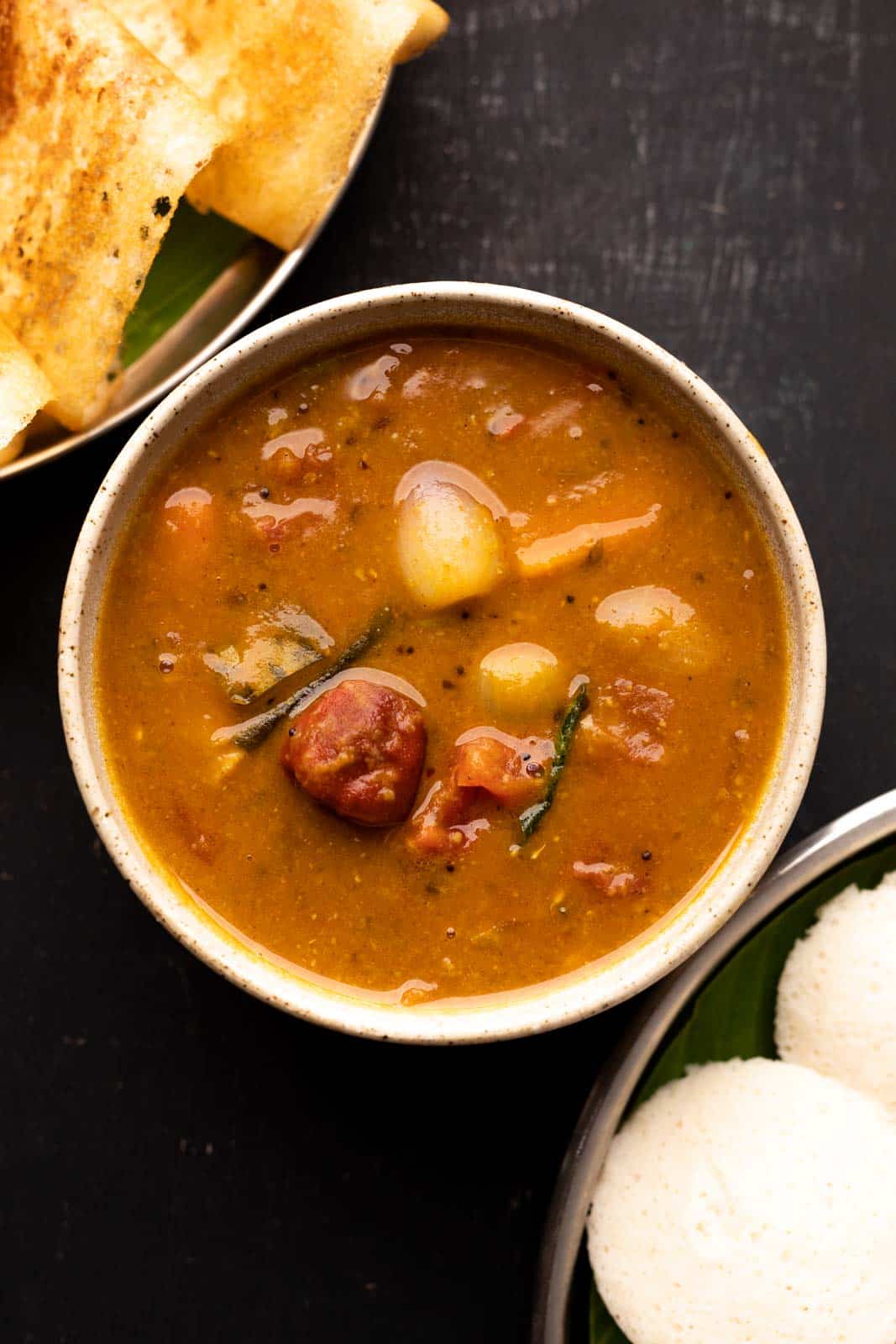
I’ve lived in South India for a while now and of course I’m a convert - meaning, every few days I crave fluffy idlis and crispy dosas with Chutney and sambar. There are so many versions of sambar. Literally every single south Indian household will have their own recipe. This recipe is based on what I learnt from my husband’s side of the family and my south Indian friends! This is your one-stop-shop kinda recipe for sambar for idlis, dosas, and vada. It’s really simple and foolproof, so keep it handy when you’re making a south Indian breakfast!
Quick Walk Through: Sambar for Idli Dosa
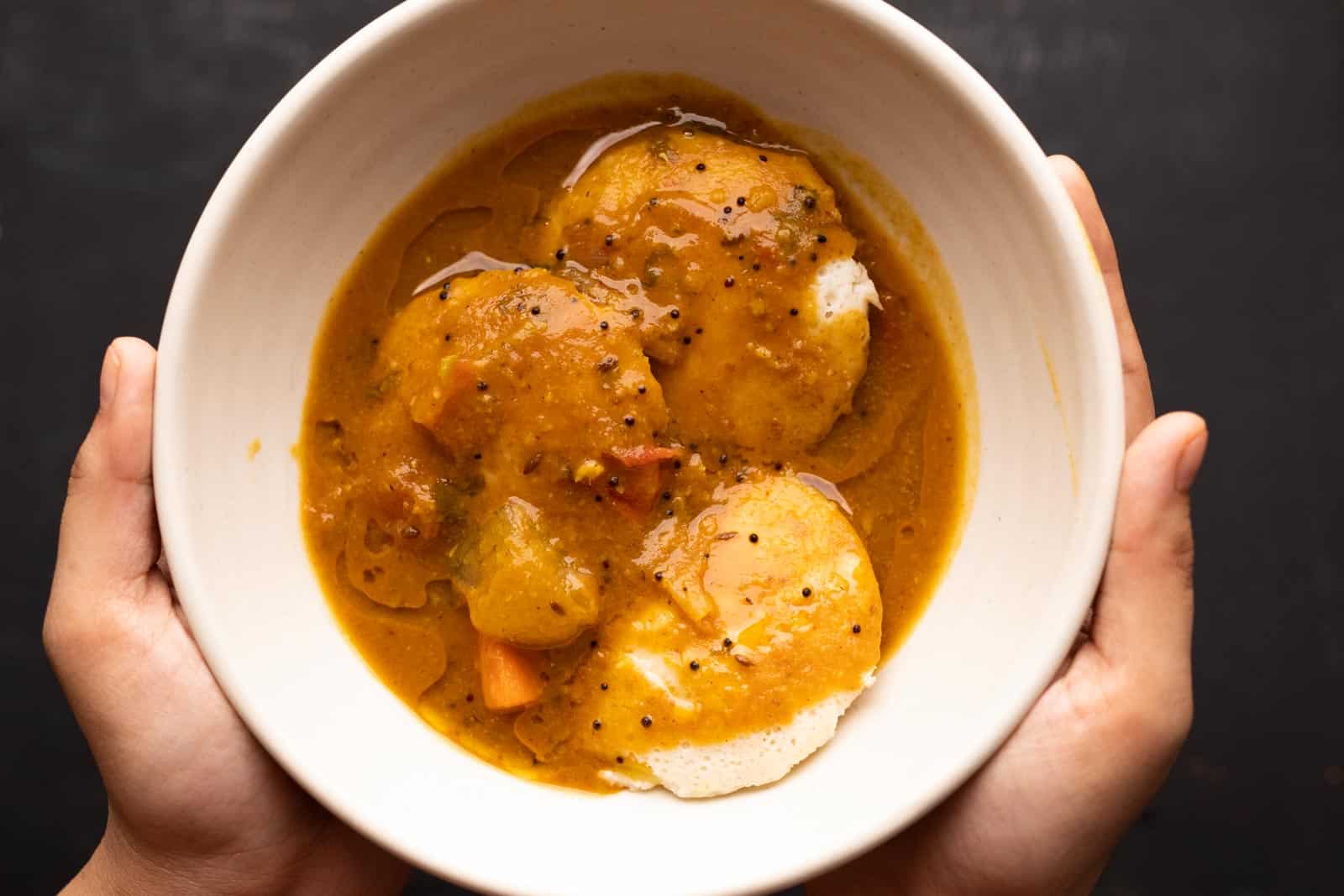
The Secret to Quintessential Karnataka-Style Sambar Flavours
The secret to getting that distinct south Indian sambar flavour lies in the sambar podi or powder that you use. I’m too impatient to make a sambar podi of my own. However, there are plenty of packaged sambar powders available in supermarkets that you can try! In this sambar recipe, we've used MTR Sambar Masala and shown you how to turn store bought sambar masala into a fantastic sambar!
A bunch of other Indian spice powders go into making sambar. Chilli powder, coriander powder, tamarind pulp for tanginess, and jaggery for sweetness are some of them. These ingredients come together to balance the flavours in terms of sweet, sour, spicy and tangy.
Frequently Asked Questions
South Indian sambar is a good mix of tangy, sweet, and spicy flavours from tamarind, jaggery and sambar podi (powder). It’s usually orangish in colour and has lentils and lots of veggies in it to munch on. The consistency is more watery than dal, almost like a soup that you can sip on just like that!! Vegetable sambar is packed with proteins and nutrients, making it one of those super healthy breakfast options!
Sambar is always made with toor dal or split pigeon peas (yellow). It’s important to wash the lentils first before cooking. The lentils are cooked in the pressure cooker along with some garlic for flavour and turmeric powder for that bright yellow colour.
Vegetable sambar is a great way to make a dish with everyone’s favourite veggies! In my south Indian sambar, I like to add chunks of carrots, Mangalore cucumbers, sambar onions (shallots) and some tomatoes for that tangy flavour. The veggies are also pressure cooked and add their own flavours to the dish. I usually just use what I have on hand. Some other vegetables that taste great in sambar are drumsticks, brinjal, lady finger, white pumpkin and even beans. Using anything you have on hand can actually be a great fridge cleaning exercise!
Tempering for Sambar
Sambar without tempering is like pizza without cheese. The tempering or ‘oggarane’ as it’s called in Kannada, adds smoky and nutty notes to the sambar. Ingredients like mustard seeds, cumin seeds, dry red chillies, garlic and curry leaves get lightly toasted in ghee and add oomphs of flavour to the sambar. Asafoetida or ‘hing’ is also added for it’s unmistakable taste and aroma. The sambar is only complete when you add the sizzling tempering to it 🙂
Note: Sambar recipes across south India have a lot in common with some differentiating ingredients. Some are made with ground coconut masala, while others, like mine, are made using readymade sambar powder.
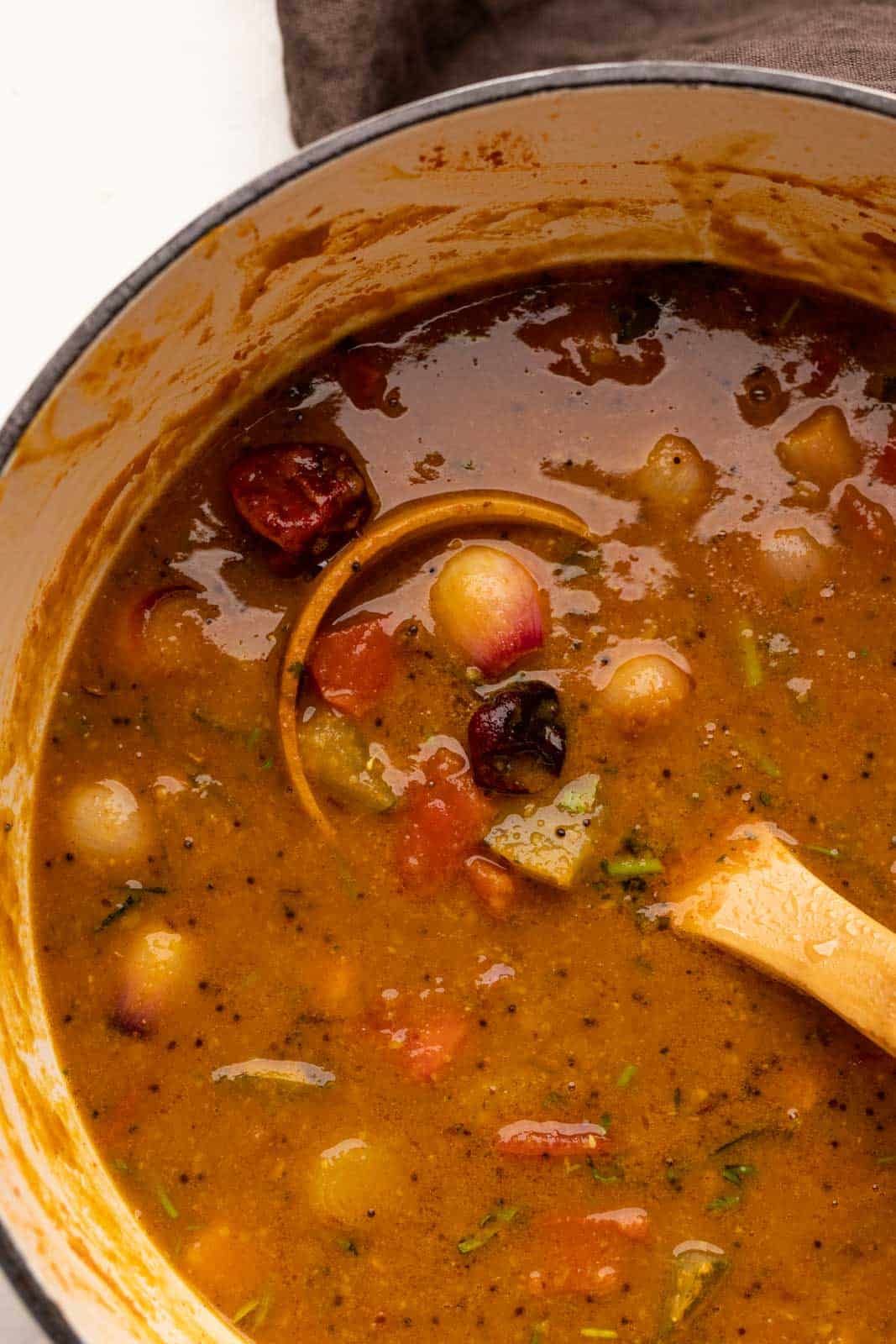
Top Tips to Make the Best South Indian Sambar:
- Once the dal is cooked, whisk it or lightly mash it to get a smooth consistency
- Add the sambar podi and spice powders before adding cooked dal. It's important to cook the masalas first to get rid of their raw flavour.
- Keep the veggies chunky, so you get big, juicy pieces with every bite
- Make the tadka or tempering with ghee rather than oil, the flavours are unbeatable - trust me!
Guys! Making sambar is super easy and after the first time you make it, you’ll be able to do it in your sleep! Plus the smell of sambar wafting in your kitchen will always warm your heart and soul.
Watch How to make Sambar at home
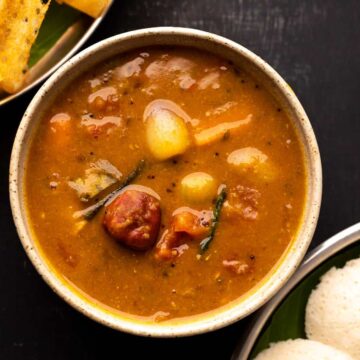
How to make Sambar
Ingredients
Dal
- ½ Cup Toor Dal washed
- ½ Teaspoon Turmeric Powder
- 4 Cloves Garlic peeled
- 2 Cups Water
Sambar
- 1 Cup Vegetables cut into chunks (we used carrots and Mangalore cucumber)
- 2 Cups Water
- 2 Tablespoons Oil
- ½ Cup Sambar Onions or Shallots
- 2 Green Chillies slit lengthwise
- ¾ Cup Tomato cut into chunks
- 1 Tablespoon Sambar Powder we used MTR Sambar Powder
- 1 ½ Teaspoons Chilli Powder
- 1 Teaspoon Coriander Powder
- 2 - 3 Cups Vegetable Stock/Water
- 2 Tablespoons Tamarind Pulp made with tamarind soaked in hot water
- 1 ½ Teaspoons Jaggery Powder or sugar
- 1 ½ Teaspoons Salt
Tempering
- 1 Tablespoon Ghee
- ½ Teaspoon Mustard Seeds
- ¾ Teaspoon Cumin
- 3 Cloves Garlic unpeeled and crushed
- 3 whole Dry Red Chillies
- 1 Sprig Curry Leaves
- ¼ Cup chopped Coriander
Instructions
Dal
- Add toor dal, garlic, turmeric and salt to a pressure cooker. Add 2 cups of water, mix and close the lid tight. Pressure cook on medium for about 6-7 whistles. The dal needs to be mashed, so ensure it is fully cooked. Cook it for longer if necessary.
- Once cooked, lightly mash with the back of a spoon or a masher and keep aside.
Sambar
- Add carrots and mangalore cucumber to a large heavy bottomed pot on a medium flame. To this add 2 cups of water and bring to a boil. Cover and cook for 10-12 minutes or until the vegetables are tender but hold their shape. They must be just tender and should not be too soft or mushy. Remove from the pot and keep aside. Reserve the water.
- Heat oil in the same large heavy bottomed pot on a medium flame. Once oil is hot, add shallots and saute for 2 minutes. Next add green chilli and saute till fragrant. Add tomato and saute for 5-6 minutes or until tomatoes are soft.
- Add sambar powder, chilli powder, coriander powder and fry till the raw smell goes, about 1-2 minutes. Add the mashed dal and mix well. Add the boiled vegetables with stock water and mix. Add 2 cups of water and mix. Lightly season with salt and bring to a boil over medium heat.
- Add tamarind pulp and jaggery powder and mix well. If the sambar is too thick for your liking, add the remaining one cup of water little by little till it reaches your desired consistency.
Tempering
- Heat ghee in a tadka pan or a saucepan on a medium flame. Once hot, add mustard seeds and cumin seeds. As they start to splutter, add garlic and fry lightly. Next add dried red chillies and curry leaves and fry till fragrant. Add chopped coriander and mix well. Turn off the flame and add this tempering to the prepared sambar.
Video
Notes
- I like this sambar with almost fully mashed dal. If you like yours to be more chunky, do not mash it as much as I have. You can also reduce the cooking time for the dal by 5 minutes.
- You can use any vegetables you like, such as drumstick, shallots, pumpkin, sweet potato etc., Remember to adjust the cooking time accordingly.
- I have used MTR sambar powder in this recipe, you can use any trusted variety.
- You can substitute fresh tamarind pulp with pre-packed tamarind paste.

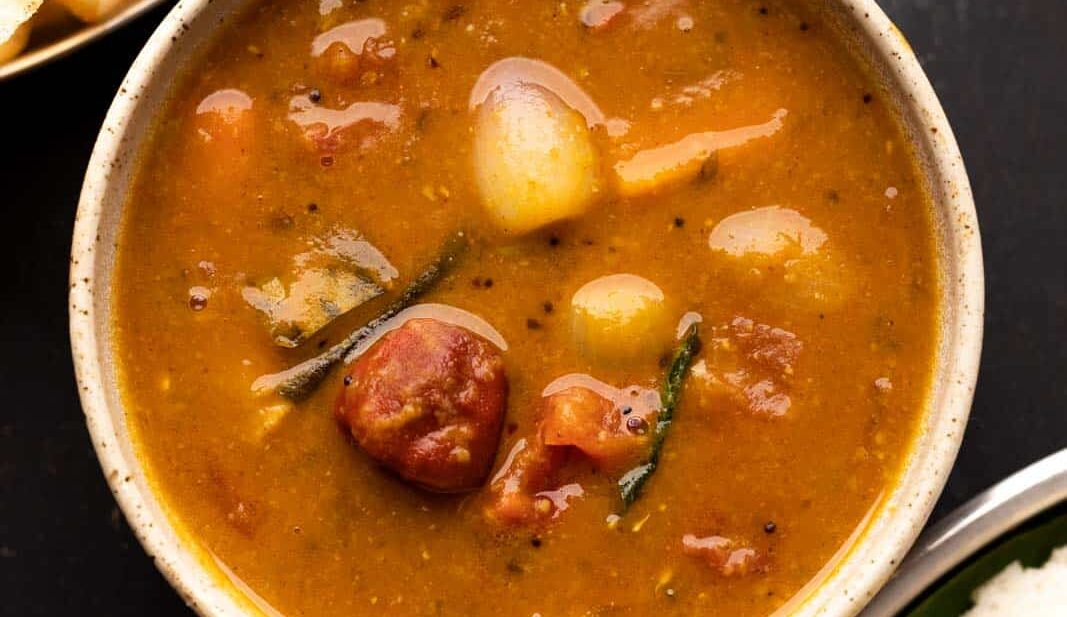
Anjali Arora says
Thank you. It help a lot for a beginner like me. Sambhar cooked well n taste yum.
Sarita says
Amazing! I love South Indian Food.Read More:- sambhar without tamarind
theflowerspoint says
Very nice recipe
Bhargav says
Preparation looked simple yet good but Without hing sambar is not sambar.
Chestha says
This was the amazing sambhar I ever tried❤️
Easwaran says
Authentic sambar does not have garlic.
The taste and flavours would be lost if Garlic is added.
Ishraque Khan says
Looks delicious. Can this be eaten with rice?
Richa says
For sure, we do that a lot.Sambar rice is yum!
Diksh says
Loved the Sambar recipe. It was perfect. I have never been able to make Sambar at home so delicious. This is definitely going to be my Go to recipe from here on 😀
Ila says
My favourite comfort food is idly sambhar and dosa ! Sambhar recipe is very different! Never add garlic in sambhar !and tempering with ghee also ! Thanks for sharing your recipes definitely try your recipe!